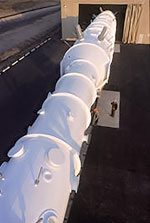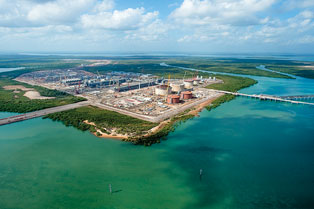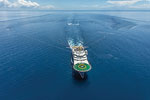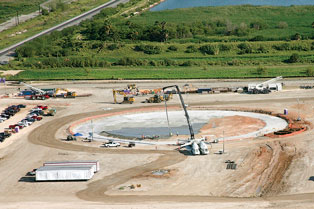Gas processing news
A. Blume, Editor
Modularized offering for smaller-scale LNG
 |
Kiewit Energy Co. and Air Products have agreed to collaborate on small-scale LNG projects in North America to meet growing demand for LNG production. The collaboration provides customers with easy availability and rapid response for the design, construction and commissioning of projects.
The modularized design and technology offered by Kiewit Energy and Air Products can be used on projects that produce up to 500 Mgpd of LNG. Through a unified approach, Kiewit Energy is responsible for project management, overall engineering and design, construction and commissioning, while Air Products leads the design and supply of the liquefaction equipment. This collaborative approach helps ensure that projects meet cost and schedule requirements.
Kiewit Energy and Air Products entered into a formal agreement to solidify the alliance in October 2015. At present, the two companies are working together on an LNG export terminal and a peakshaving facility in the US.
Ichthys field gets safety systems
 |
The Ichthys field was the largest discovery of hydrocarbon liquids in Australia in more than 40 years, and the Ichthys LNG project ranks among the largest energy projects in the world.
Operated by INPEX, the Ichthys LNG project includes some of the world’s biggest offshore facilities, massive onshore processing facilities near Darwin in Australia’s Northern Territory, and an 890-km pipeline to unite them.
HIMA was selected by the Ichthys JV to supply safety instrumented systems (SISs) and the fire and gas system (FGS). The Ichthys LNG project consists of an onshore LNG plant; a central processing facility; and a floating production, storage and offloading vessel. The total order value is the largest that HIMA has ever received for a single project.
Once operational, the Ichthys LNG project is expected to produce 8.9 MMt of LNG and 1.6 MMtpy of LPG, along with approximately 100 MMbpd of condensate, at peak.
The SISs and FGS are supplied using HIMax, the first safety system designed to provide uninterrupted system operation throughout the entire life of the plant, while maximizing plant availability, productivity and safety. SISs and FGS using the HIMax safety system hardware meet the requirements in accordance with AS/IEC 62061 and IEC 61326-3-1 (DIS).
The high-integrity pressure protection systems (HIPPSs) rely on a Planar4 system, which meets the highest safety standards and can be used up to Safety Integrity Level (SIL) 4, in accordance with IEC 61508. Onshore and offshore facilities and the pipeline are connected to around 25,000 safety input/output points, allocated in approximately 430 cabinets distributed via HIMA safeethernet technology, where applicable.
Besides the SIS/FGS/HIPPS, the HIMA scope of supply includes delivery of the pre-final-investment-decision system development and standard application design and testing. The cybersecurity and network management with related hardware installation, the addressable fire system for the living quarters with the related detectors, and the network management system for the SIS/FGS network complete the deliverables.
The HIMA hardware and firmware provided are certified up to SIL 3, according to AS/IEC 61508. HIMA will use the principles of AS/IEC 61511 in designing and testing the SISs and FGS. The functional safety management (FSM) plan will be used to manage all stages of the design, implementation and manufacturing processes.
Gas turbine market forecast at $100 B
Worldwide installations of new gas turbines will average 74,000 MW/yr over the next five years, according to a report by McIlvaine Co. The system sales revenue will be $75 B/yr. GE, Siemens and other turbine vendors will generate revenues of $20 B/yr for the turbine equipment.
Worldwide installed gas turbine capacity is 1.5 MM MW. Purchases of repair parts consumables and upgrades at existing power plants is expected to average $30 B/yr. Part of this investment will be a result of greenhouse gas initiatives. The least expensive way to reduce carbon footprint is to make the existing gas turbine more efficient. Adding the steam cycle makes the biggest difference, but there are other options available.
Inlet filter replacement for existing units is seen at more than $500 MM/yr. Another $460 MM/yr will be spent for SCR systems and catalyst. Additionally, McIlvaine Co. expects the market for replacement parts for pumps and valves to be significant.
Automation for Finland’s first LNG import terminal
Honeywell will provide its Experion Process Knowledge System (PKS) automation controls and tank gauging systems for Finland’s first LNG import terminal to efficiently supply natural gas to marine vessels and industrial facilities in Finland, helping replace other fuels that have higher emissions. The cleaner-burning natural gas will help these vessels and facilities meet emissions regulations in the Baltic and Nordic seas.
Additionally, Honeywell’s Enterprise Buildings Integrator (EBI) will connect and power comfort, safety and security systems within the terminal itself, creating a productive environment for workers. With tight integration between Experion PKS and EBI, operators will have one interface to access and manage all process and facility technology, which improves sitewide visibility and efficiency.
The Pori LNG terminal will have a capacity of 30,000 m3 and will be completed in the second half of 2016. Honeywell’s tank-gauging systems will be used on tanks provided through Spanish engineering company FCC Industrial e Infraestructuras Energéticas SAU.
BG takes equity in Aphrodite discovery
 |
BG Group has secured a 35% holding in Block 12 offshore Cyprus, which includes the Aphrodite gas discovery. This upstream position provides a potential source of gas to Egypt, where BG Group holds equity in the two-train LNG export facility at Idku, as well as LNG offtake rights to lift 3.6 MMtpy.
Operated by Noble Energy, the Aphrodite gas discovery is located approximately 170 km south of Limassol. Completion of the transaction is subject to regulatory approvals and closing conditions.
GE signs expanded contract with Cheniere
 |
GE Oil & Gas has signed a $610-MM agreement with Corpus Christi Liquefaction LLC, a subsidiary of Cheniere Energy Inc., to provide spare parts and planned inspections, maintenance services and around-the-clock technical support for the gas turbines and refrigerant compressors on the first two LNG trains under construction at Cheniere’s LNG export facility in Corpus Christi, Texas.
Each train will have six gas turbines and is expected to have nominal capacity to produce up to 4.5 metric MMtpy of LNG. The contract—the second for both companies—serves as a model for large infrastructure projects in terms of efficiency, cost savings and facility reliability.
Construction of GE equipment onsite will start in January 2017, with LNG production scheduled to commence as early as 2018. The new contract, which covers 20+ years, incorporates all major maintenance for the LNG trains, including parts, repairs and field services.
In addition, GE will provide a resident technical support team at Cheniere’s facility to assist with all aspects of maintenance of GE equipment and include a remote monitoring system for the equipment. Cheniere will benefit from access to OEM parts and repairs, plus technical expertise of GE field engineers and technology—all of which will ensure optimal reliability.
GE Oil & Gas and Cheniere also have announced a similar, $1-B maintenance agreement for the Sabine Pass facility in December 2014. Cheniere is developing the liquefaction project in Corpus Christi with anticipated aggregate capacity of up to 22.5 MMtpy over five trains.
The IEA forecasts global demand to reaccelerate and grow at an average rate of 2% through 2020, with an average annual increase of 10% projected throughout the rest of the decade. Demand for European LNG imports is projected to roughly double in that time period.
Brazilian pipeline center tests pigging
The Brazilian Pipeline Technology Center (CTDUT), located in Rio de Janeiro near the Duque de Caxias Refinery, was chosen by Shell in Houston, Texas, to develop tests and research on pipeline pigging. Shell’s engineers are trying to develop reliable mathematical models
for bypass pig operations for cleaning pipelines under single-phase (water) and two-phase (water and air) flow.
The work began about two years ago in Houston when Shell, in a partnership with a local company, developed a special “capsule” sensor that is attached to the pig body and that records pressure and temperature data on board. In addition, Shell acquired a Rosen Technologies pipeline data logger to record pressure, differential pressure (upstream and downstream of the pig), temperature and data from a navigation system for the local coordinates, while the pig travels along the pipeline. These devices permit the diagnosis of internal conditions.
According to a CTDUT research engineer, the main challenge of the process is to discover the best combination of the pig disks and the orifice diameters for controlling the flowrate through the bypass. The disk diameters are usually a little larger than the inside diameter of the pipeline, which basically controls the wax rate of cleaning. On the other hand, the control of the flowrate through the bypass is critical since it has an important role on the resulting force that pushes the pig through the pipeline. Therefore, choosing the right cross-sectional area of the bypass orifices is critical to achieving a good result. Too much bypass may cause the pig to stall, while not enough bypass may cause wax (or other solids) to plug the line.
Since the installation is flexible in its general configuration, a 2.5-m transparent section was installed by Shell so that its tests could be analyzed and filmed during the pig passage. In the two-month period, more than 200 tests were made.
At present, CTDUT is in the process of installing a new control and automation system for this loop, which will allow the complete automatic control of conditions, such as pressures, temperature, flowrate and pig-position monitoring along the entire pipeline. This will also allow for the preparation of quick reports and the analysis of large data sets generated by the system sensors.
First gas flows from Corrib field in Ireland
 |
Natural gas has started to flow from Shell’s Corrib gas field, marking an important milestone for Ireland and for Shell’s upstream operations. Located 83 km off Ireland’s northwest coast in water depths of almost 350 m, the Corrib gas field lies approximately 3,000 m below the seabed. At peak annual output, the Corrib gas field is expected to produce around 260 MMscfd of gas, or 45 Mboed. Corrib has the potential to meet up to 60% of Ireland’s gas needs.
Six wells have been drilled at the Corrib field, with gas transported to the Bellanaboy Bridge Gas Terminal in northwest Mayo through a 20-in. pipeline. The gas is processed at Bellanaboy before it is transferred into the Gas Networks Ireland (GNI) network, which delivers
it to Irish gas consumers.
The Corrib project is a JV between Shell E&P Ireland Ltd. (45%), Statoil Exploration Ireland Ltd. (36.5%) and Vermilion Energy Ireland Ltd. (18.5%). Shell E&P Ireland Ltd. is the project’s operator.
Qatar to supply additional LNG to India
RasGas Company Ltd. of Qatar and Petronet LNG Ltd. of India have entered into a binding sales-and-purchase agreement (SPA) for the supply of an additional 1 MMtpy of LNG to India. Deliveries will begin in 2016 to four Indian entities: Indian Oil Corp. Ltd., Bharat Petroleum Corp. Ltd., GAIL (India) Ltd. and Gujarat State Petroleum Corp.
RasGas and Petronet LNG have also entered into a binding agreement to adjust some aspects of their existing long-term LNG SPA of 7.5 MMtpy, signed by the parties in 1999, which laid the foundation for the LNG business in India. Such adjustments will protect and preserve the overall value of the contract.
As per the agreement, LNG volumes that were not taken by Petronet from RasGas during 2015 will be taken and paid for by Petronet during the remaining term of the SPA, maintaining its current level of oil indexation with the oil index more closely reflecting the prevailing oil prices.
RasGas is a main supplier of LNG to India and has been supplying Petronet since 2004.
Golar gets financing for FSRU
Golar LNG Ltd. has received an underwritten financing commitment for the newbuild FSRU Golar Tundra. China Merchants Bank Leasing will fund the vessel on a charter-free basis, based on its current cost of up to $216 MM. The facility also provides for Golar Tundra’s eventual sale to Golar LNG Partners LP. On the charter-free basis, the facility will finance a minimum of $50 MM more than the final delivery payment to the shipyard, thereby releasing the additional cash to Golar.
As part of the financing commitment, China Merchants Bank Leasing will provide a parallel facility to refinance the Golar-owned FSRU Golar Eskimo. Upon drawdown, this new facility will refinance the vessel’s $156 MM debt and provide approximately $100 MM of additional financing.




Comments